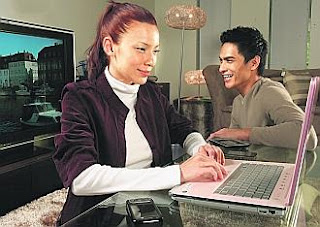Ubuntu Linux - Carry the Ubuntu OS in your hand
Install it in a portable flash drive, and boot into your own system on any PC, says LIM YEE HUNG
This article is compliment from Straits Times Digital Life and Mr Lim Yee Hung
TIRED of having to familiarise yourself with new settings each time you use a different computer?
Load the entire Ubuntu operating system (OS) into a flash drive. It's do-able because the OS takes up just 2GB of space compared to Windows Vista's 20GB.
Then, simply plug in the Ubuntu-installed flash drive into any computer and, like Agent Smith in the Matrix, you will be able to 'clone' your own computer settings onto the new PC.
What you need:
*Internet connection
*USB portable flash drive of at least 2GB. (Make sure that the flash drive is empty as any data on it will be erased once you install the OS.)
<>
*Ubuntu Live CD - order it for free from www.ubuntu.com or create one (download from the website and burn it onto a CD).
What to do
THE following instructions will make use of the command line interface, somewhat like the MS-DOS application. In Ubuntu, it is called Terminal.
In it, you will be required to type in computer commands, as opposed to just clicking on a few buttons with your mouse. Take note that all commands are case-sensitive.
Step 1
FIRST, boot your computer into Ubuntu. If you don't have the OS installed, use the Live CD to boot up Ubuntu instead. Make sure that both the CD-ROM and the flash drive are plugged into the computer. Then, run the Terminal application (Applications >Accessories >Terminal).
Step 2
TYPE 'sudo su' and enter your administrator password to give yourself full access privileges.
Type 'fdisk -l' to list all the drives and partitions in your computer. You should see your flash drive listed under '/dev/sdx', where x is the letter assigned by your computer to the drive. So, if your flash drive is listed under '/dev/sdb', replace x with b for the following instructions.
Type 'umount /dev/sdx1' to unmount the flash drive, allowing you to configure it.
Type 'fdisk /dev/sdx'.
Type 'p'. You will see all existing partitions on the drive. Press 'd' to delete them.
Type 'p' again to check if all partitions have been deleted; if not, repeat the delete command.
Once that's done, type 'n' to make a new partition.
Type 'p' to create a primary partition.
Type '1' to make this the very first partition.
Press the 'Enter' key to use the default cylinder.
You will then be prompted to set your partition size. Set it to 750MB by typing '+750M'.
Type 'a' to make the partition active.
You will now need to set the file system of this partition, so type '1' to select the partition.
Type 't' and then '6' to set the filesystem to the FAT16 filesystem.
Create a second primary partition by typing 'n', followed by 'p', then '2'.
Press the 'Enter' key twice to use the default cylinder and the default last cylinder.
Type 'w' to edit your partition table.
Unmount the first partition by typing 'umount /dev/sdx1'.
Format the partition by typing 'mkfs.vfat -F 16 -n ubuntu710 /dev/sdx1'.
Then, format the second partition by typing 'umount /dev/sdx2', and then 'mkfs.ext2 -b 4096 -L casper-rw /dev/sdx2'.
Step 3
NOW remove your flash drive and plug it in again.
Type 'apt-get update' in the Terminal window. You should see a long stream of text as Ubuntu looks up the latest updates for your system.
Step 4
YOU will need to install the Syslinux and mtools applications, so type 'apt-get install syslinux mtools'.
Enter 'y' for 'yes' when prompted whether you wish to install the application.
<
Type 'syslinux -sf /dev/sdx1'.
Step 5
NOW you will need to use the files on the CD-ROM.
Type 'cd /cdrom' to access the CD-ROM directory.
Type 'cp -rf casper disctree dists install pics pool preseed .disk isolinux/* md5sum.txt README.diskdefines ubuntu.ico casper/vmlinuz casper /initrd.gz media/ubuntu710', to copy the files from the CD-ROM to your flash drive.
You may see errors stating that the system 'cannot create symbolic link'. Ignore them.
Step 6
TYPE 'cd' to return to the previous directory. Next, download a zip file from the Internet.
Type 'wget pendrivelinux.com /downloads/u710fix.zip' to download the file.
Type 'unzip -o -d /media/ubuntu710/ u710fix.zip' to extract all of the files in the zip file to your flash drive.
Step 7
NOW you are all set! Remove your CD and reboot the computer (leave the flash drive plugged in). You should now see the Ubuntu bootup menu.
Choose the 'Run in persistent mode - USB' option each time so that all settings will be saved for every boot.
Got trouble? Look here
IF YOU have trouble booting into Ubuntu on your flash drive after following the instructions, check for these two reasons:
Your computer is not set up to boot up from USB drives. Reboot your computer, and at the startup screen go to the BIOS Menu (press the F2 key). Make sure that the computer's boot menu includes USB drives, and put them on the top of the priority list. Save your changes and restart the PC.
If you still encounter problems, your flash drive's Master Boot Record (MBR) may be corrupted. Repair it by booting into Ubuntu normally and typing 'apt-get install lilo' in the Terminal application. Then enter 'y' if prompted for permission to install the program. Once it is installed, type 'lilo -M /dev/sdx' to repair the MBR.
Lim Yee Hung is a PC enthusiast studying in Britain
Labels: ubuntu, ubuntu linux





